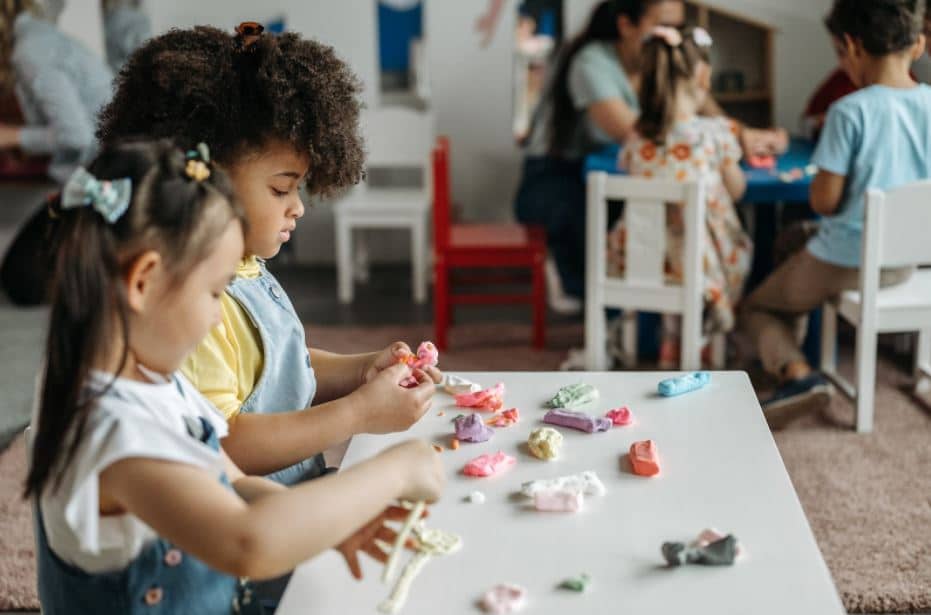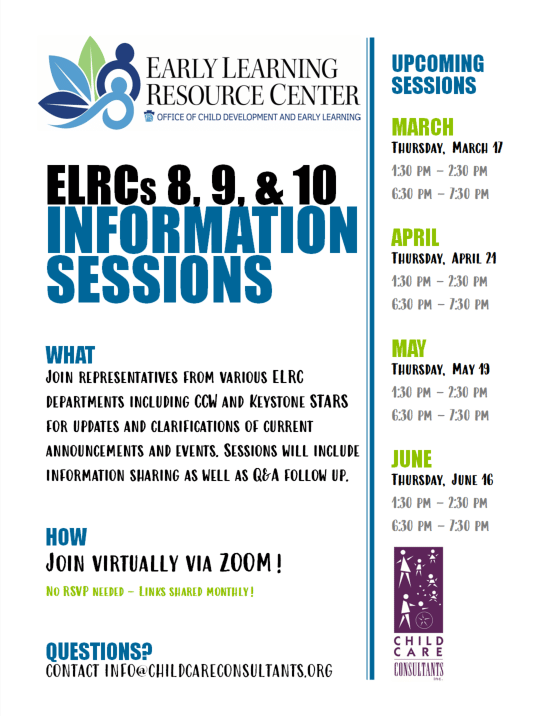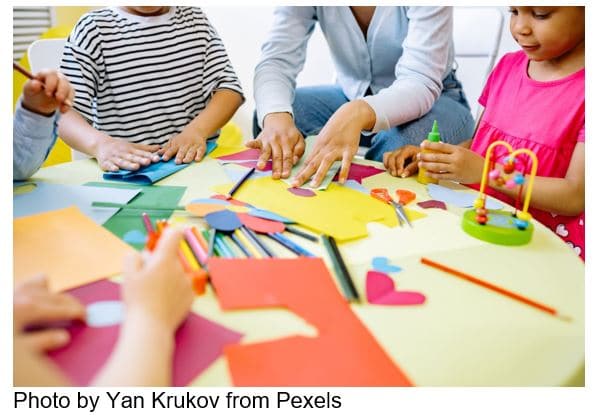
Written By: Erica Heller, Alyssa Hahn, Sara Copeland, Sally Melder, Lisa Young, and Christy S. Renjilian
When you think of continuous improvement, what comes to mind? An automotive assembly line circa 1940? Or your latest meal-prepping session, your countertop organized with food in various stages of completion, ready to be set strategically in your fridge for the upcoming week?
Or in your business, maybe it’s process improvement, logistics, or up-leveling your client’s experience.
Have you ever thought about continuous improvement in the childcare industry?
Children are, after all, the most important thing in our lives.
But did you know that there is a statewide program in Pennsylvania called Keystone STARS? It’s designed to assist childcare providers with quality improvements.
Pretty impressive.
And if you’ve heard of it, maybe even benefited from it, you may not know what role Community Connections for Children, Inc. plays in their programs here in our region.
So today, we’re pulling back the curtain on the program and bringing you an in-depth look at Keystone STARS (and the people behind it!).
What is Keystone STARS?
Keystone STARS is a program funded through the Pennsylvania Office of Child Development and Early Learning. The acronym of STARS stands for Standards, Training/Professional Development, Assistance, Resources, and Supports.
And Community Connections for Children, Inc. serves as an early learning resource center for 13 counties in Pennsylvania, administering and maintaining the program.
Keystone STARS has four primary goals:
- To improve the quality of early care and education
- To support early care and education providers in meeting their quality improvement goals
- To recognize programs for continuous quality improvement and meeting higher quality standards
- To provide families a way to choose a quality early care and education program
At its core, STARS is a continuous quality improvement program designed to support child care programs in providing the very best care and education to children.
Quality early childhood education is made up of two components, structural quality and process quality.
Structural Quality often defines the foundational or regulated components of a quality program and includes aspects such as group size, children-to-teacher ratio, and teachers’ qualifications.
Process Quality focuses on the dynamic and human aspects that support the daily experiences of children, things like social, emotional, physical, and instructional aspects of children’s activities and interactions with teachers, peers, and materials.
The depth of STARS knowledge at Community Connections for Children Inc. runs deep. The CCC team has a combined 420 years of experience in the early childhood field. And offers many types of support, including:
- Quality Coaches
- Designators
- Technical Assistance Coaches
- Inclusion Support
- Community Engagement
- Nature Play Consultants
- Health Consultants
- Information Technology Consultants
And Keystone STARS has four designation levels to help parents find quality care.
STAR 1 designation means the provider has a full Department of Human Services license whose regulations focus on health and safety.
STAR 2-3-4 programs work with STARS Quality Coaches to systematically build upon the DHS regulations and increase quality by focusing on Staff Qualifications, Early Childhood Education Program, Partnerships with Families and Communities, and Leadership and Management Practices.
The increase of quality in program policy, procedures, and curriculum from participation in STARS directly impacts staff, children, families, and communities in a positive way.
How Does STARS Make an Impact?
The program has a great impact on children, families, and educators. Here in central and southeastern Pennsylvania, Community Connections for Children, Inc. serves 573 providers.
For children, it helps provide a quality space for learning, growth, and development. For parents, it gives peace of mind, helps them evaluate and select quality care, and supports their role as their child’s first (and long-term) teacher. And for educators, it helps to increase their knowledge and skills in working with children and families.
In the K-12 school system, STARS ensures children are better prepared, with socio-emotional, pre-literacy, and pre-numeracy skills. Kindergarten teachers are able to build upon that strong foundation.
And the STARS program impacts local economies — it enables families to enter or remain in the workforce because they have access to quality childcare.
The impact is easiest to see when talking directly to the small business owners and early childhood educators we work with day in and day out.
So, we pulled together words and messages directly from them, our clients, to showcase how our team assists them and what it means, in their own words…
“Of all the training videos I’ve watched, you are the best teacher…by far!!! Thank you for your work/efforts and obvious care/passion for your profession.”
“Thank you for everything you do for children and families and for leading the Health and Safety Task Force meetings! Your meetings are very informative, and I look forward to them every month.”
“I shared your email with my staff using PATHS and the general consensus is that we love the curriculum. It is still amazing to see the children using their words with their friends and using the turtle method to solve problems. This curriculum has definitely become an asset.”
“One of the people that has helped us tremendously to get where we are today is our ELRC coach. She has been walking beside us and helping us through many of the processes that we need to go through. We are very appreciative of all the help she has given our center.”
“This message comes today because of my deepest appreciation for my Quality Coach. She has been nothing short of FABULOUS in the transition. She has been more than patient, understanding, and extremely helpful to me moving to a STAR 4. The renewal process, online forms that I am not confident with, and everything else she has done to support me during this whole COVID thing. She’s a gem, and you’re lucky to have her working for you!”
“I just want to say thanks for all you do to keep us all informed and up to date with the latest information. I have just spent about 3 hours going through the ELRC Newsletter, and the links and information contained are invaluable. As always, you provide the support and guidance that we all need right now.”
It’s clear the staff at Community Connections for Children, Inc. provides exceptional, personalized support to its clients. And impacts children, families, educators, and the overall economy.
How does a childcare provider reach out to be part of the program?
If you’re a childcare provider, reach out through our website or by calling our office at (800) 864-4925.
You may have reservations about the “paperwork” aspect of STARS. However, the paperwork has been greatly reduced over the years.
You may even believe that you are operating a quality program and shouldn’t have to go through the process to demonstrate how your program aligns with the STARS standards. Good news! Our Quality Coaches work with you every step of the way.
Many providers are curious and eager to learn yet may feel information overload when first exploring STARS. After your initial meeting and working with a coach, you’ll feel more confident as you work together and break down information for you to complete in ‘baby steps.’
Once involved in STARS, many providers gain confidence in the program and in understanding the intent of the standards, and then they find it to be not so overwhelming. Providers can work with the Quality Coaches at whatever level or need their program is at and successfully move up to the next STAR level.
When a provider comes to Community Connections for Children, Inc. with an interest in Keystone STARS, a coach will meet with them to gauge interest and help them through the designation process.
Support is personalized, based on each provider’s goals and needs. It often includes:
- Initial resources and support
- Coaching
- Orientation
- Monthly information sessions for providers
Our approach is to see what each program is doing and assist the provider in increasing the quality of what they are doing while maintaining their individuality.
We often hear how surprised providers are about their ability to build a real relationship with their Quality Coach. And even after a provider achieves the higher STAR levels, CCC Coaches will continue to coach them and support their efforts to stay up to date on the latest best practices and even incorporate additional programs—such as STEM, nature-based play, or socio-emotional curriculum.
And anyone can sign up for our e-newsletters, visit our website, or follow us on Facebook.
Why do parents need to know about Keystone STARS?
Each parent wants the best for their child. And quality early childhood care is essential.
A child’s brain and socio-emotional skills are rapidly developing in the first five years. There is no other stage of life when their brain will be developing so quickly. And research proves that what happens in the first five years matters—it greatly impacts the rest of a person’s life.
By enrolling your child in a high-quality program, you are helping to ensure that your child will be successful in K-12 and life. So ask your child’s provider if they participate with Keystone STARS, or have plans to explore the program.
We encourage parents to base their childcare decisions not just on the cost of care, or the location of the care, but on the quality of the care.
Just like many adults make housing decisions based upon which school district their child would attend, they should pay as much attention to the quality of the child care programs in the area.
And the STARS program helps with that; it helps parents evaluate each facility and make an informed decision. It helps them know what a high-quality childcare program sounds, feels, and looks like.
For more information, visit our website.
About Community Connections for Children, Inc.
Community Connections for Children, Inc. (CCC) is a nonprofit centered in the heart of Pennsylvania. They serve childcare providers and low-income families ‒ the ones that have been impacted the most by the pandemic.
For you and your business, CCC helps keep childcare options open for your employees ‒ saving missed work hours and lowering on-the-job stress levels. They work with early childhood education programs and home-based providers to improve the quality of care, ensuring that all children enter school ready to be successful.
Christy Renjilian serves as its Executive Director. Erica Heller serves as the STARS Manager/Assistant ELRC Director.
To learn more, visit childcareconsultants.org.









